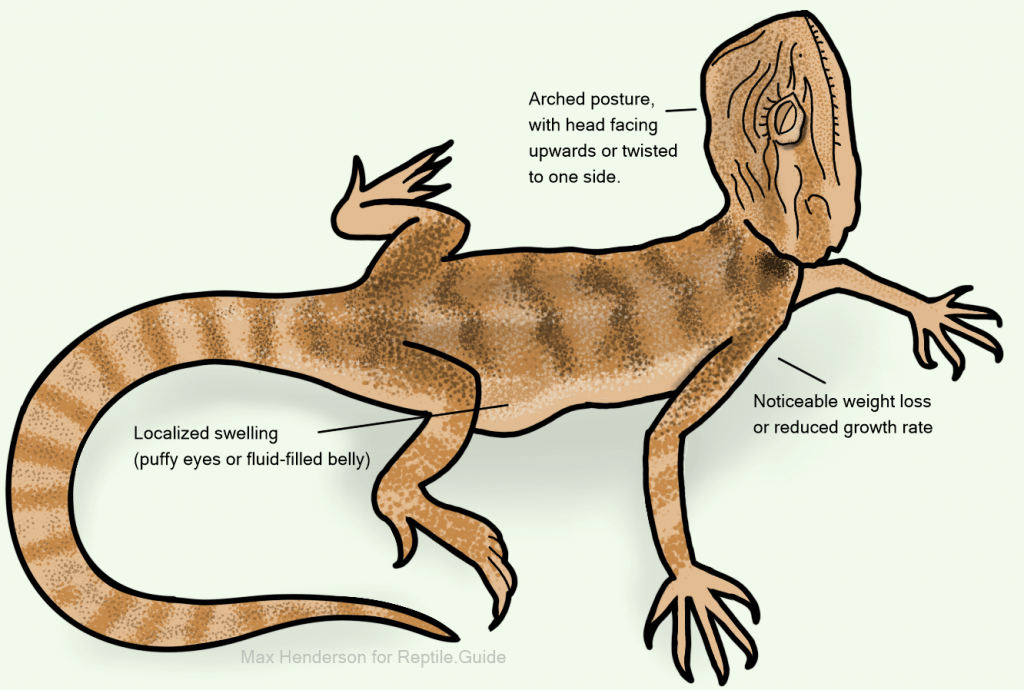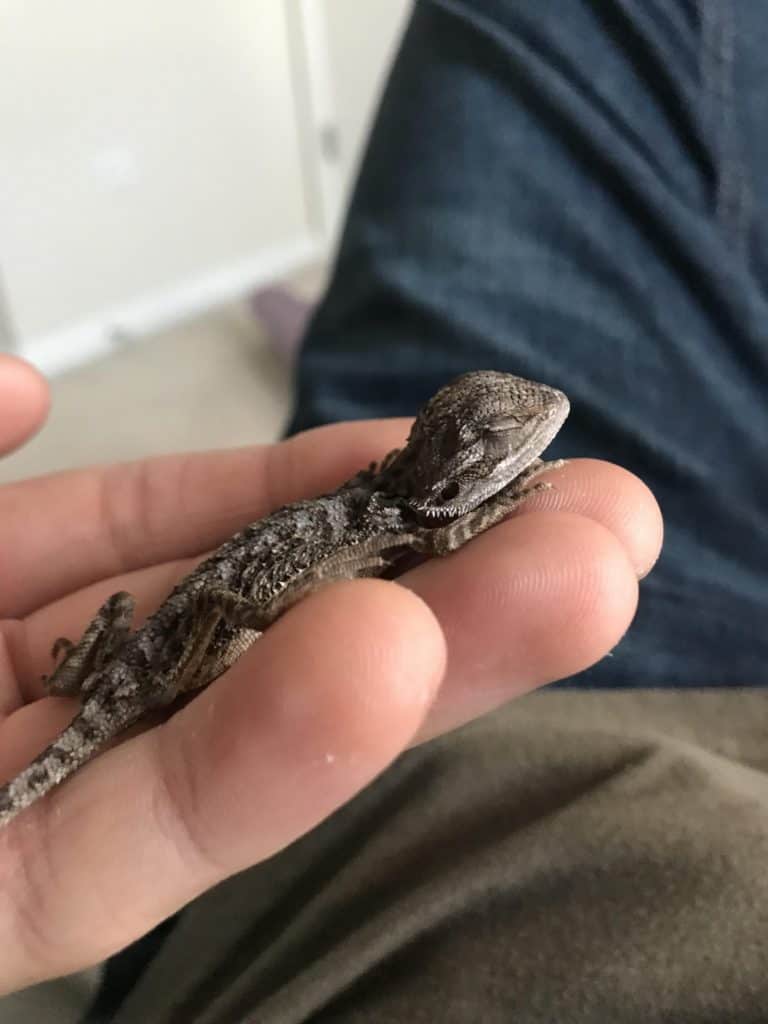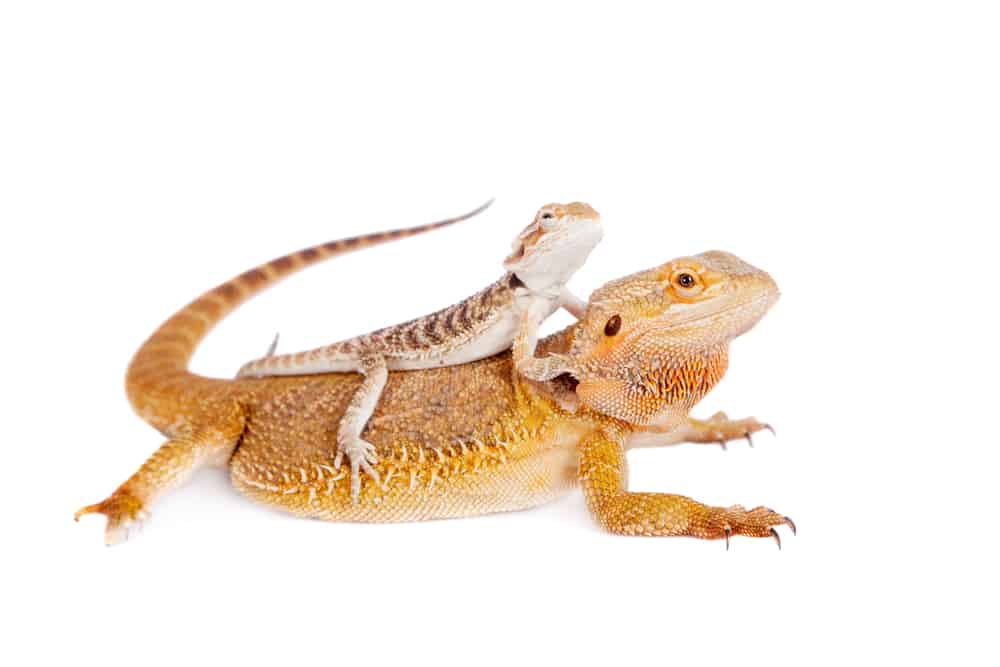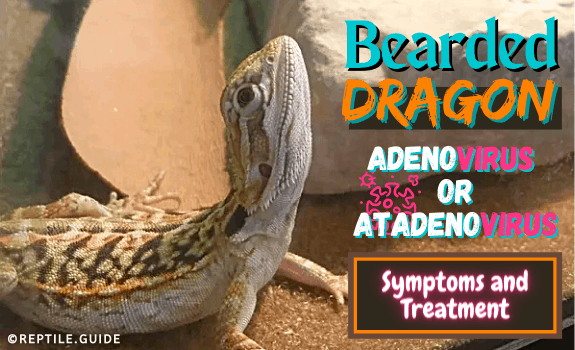Is your bearded dragon arched in an unusual position? Has it been suffering from weight loss or refusing to eat?
These are the most common symptoms of atadenovirus. They call for immediate attention!
Atadenovirus – also known as “adenovirus” or “wasting disease” – is a life-threatening, contagious disease caused by a viral infection.
It’s also (unfortunately) quite common in bearded dragons.
Thankfully, it doesn’t have to be a death sentence.
It’s impossible to predict how a beardie will react until it becomes infected, but not all bearded dragons develop life-threatening symptoms.
Still, as any keeper who has had atadenovirus crop up in their collection will tell you:
It’s always better to take pre-emptive steps to avoid contamination than to rely on treating the disease when symptoms appear.
In this article, you’ll learn all you need to know about atadenovirus, including:
- Symptoms
- Treatment
- Veterinary diagnosis
- Best methods of prevention
In This Article
Stargazing Bearded Dragon
A stargazing bearded dragon is, perhaps, the most obvious warning sign that can alert keepers to a case of atadenovirus.
“Stargazing” is when a bearded dragon – or another reptile – arches its head directly upwards towards the ceiling for extended periods.
This behavior usually manifests itself alongside other involuntary movements, such as twitching or seizures.
Stargazing behavior is a result of damage to the nervous system caused by an advanced case of atadenovirus.
The virus has begun to affect the lizard’s brain and spinal column.
This damage causes the animal to arch into unusual and uncomfortable poses as it loses control of its muscles.

Adenovirus in Bearded Dragons Symptoms
Stargazing is not the only symptom of atadenovirus. Atadenovirus can produce a wide variety of symptoms in bearded dragons.
Atadenovirus (adenovirus) in bearded dragons symptoms include:
- Low appetite
- Slow growth rate
- Sudden weight loss
- Constipation or diarrhea
- Unusual, localized swelling
- Weakness and inability to stand
- General poor health (unthriftiness)
- Erratic movements, twitching, or seizures
- Longer than usual spend sleeping or hiding
Each individual can react quite differently to an atadenovirus infection.
The broad range and diversity of symptoms associated with this disease can make it difficult to diagnose based on symptoms alone.
Symptoms can also vary by the age of infection.
Hatchling beardies that are infected from birth often seem to spend longer than average hiding or sleeping.
They also fail to put on weight at a normal rate. They may even lose weight, which is incredibly concerning for young beardies.
A hatchling beardie should grow to around five to nine inches by the end of its second month.
Check out our dedicated article to read more about bearded dragon growth rates.
Bearded dragons that become infected with atadenovirus during adulthood may develop organ problems, parasitic infections, and other general health issues.
Atadenovirus-positive animals suffer from a weakened immune system.
Immune suppression increases the severity of parasitic infections and other diseases, such as gastroenteritis, stomatitis, and kidney or liver disease.
Reptiles with an active case of atadenovirus will likely have trouble fighting otherwise mild illnesses.
Some infected adults die suddenly. Others develop severe, obvious neurological issues – like stargazing or seizures.
Swelling is another unusual symptom of the disease, caused by a fluid buildup within the body cavity.
This swelling is often localized to the eyes, beneath the chin, or along the belly.
Swelling can be indicative of liver failure, a severe complication associated with advanced atadenovirus infections.
Some animals surviving for long periods with atadenovirus will experience periodic flare-ups.
During a flare-up, beardies may lose their appetite, develop constipation or diarrhea, and sleep more than usual.

Atadenovirus
Atadenovirus is caused by – you guessed it – a virus.
Though a virus is not technically a living organism, it can evolve and change in similar ways.
Atadenoviruses belong to a family of viruses called the “Adenoviruses” (Adenoviridae).
This family includes species that affect humans and a range of other vertebrates, but thus far, none of the Atadenoviruses affect humans.
There are around ten species of Atadenovirus currently described.
Two of these Atadenovirus species can affect lizards: Lizard Atadenovirus A and Lizard Atadenovirus B.
One Atadenovirus species can also affect snakes, while the rest affect mammals (but not humans).
You’ll notice that many reptile-specific sources use the terms “Adenovirus” and “Atadenovirus” interchangeably.
All of the viruses within this family known to infect reptiles belong to the genus “Atadenovirus.”
Like most viruses, Atadenoviruses penetrate cells in the host’s body and insert their genetic information into the cell’s nucleus.
This information causes the cell to manufacture more viruses, which is how infection begins.
A virus cannot reproduce without the help of host cells but can still infect surfaces.
We’ll discuss the primary ways atadenoviruses can spread in the next section.
How Does Adenovirus Spread?
All adenoviruses – including reptile atadenovirus – are highly contagious and spread quickly through direct contact between infected and non-infected animals.

Atadenovirus can pass through saliva, blood, and other bodily fluids.
These modes of passage make it easy for one member of a breeding pair to infect the other or for a single infected juvenile to infect its tankmates.
Atadenovirus can also spread through contact with infected surfaces, equipment, or uneaten food.
Live foods can carry atadenovirus if they’ve been exposed to it by a reptile.
If – for example – an uneaten cricket is moved from a lizard’s enclosure back to your feeder cricket colony, then that cricket may infect the entire colony!
Food, calcium, or water bowls can also become infected.
Switching bowls between enclosures (without proper sanitization) is a significant cause of cross-contamination.
The same applies to non-food-related equipment, such as feeding tongs, hides, and enrichment items.
Atadenovirus can also pass from an infected mother to her offspring.
For this reason, don’t assume that a hatchling beardie is 100% free of disease.
Hatchlings with atadenovirus rarely survive more than a few months.

Other Common Bearded Dragon Conditions (With Similar Symptoms)
Due to its wide range of different symptoms, some other common conditions can present similarly to atadenovirus in bearded dragons.
Note: Even though they can be entirely unrelated – parasitic infections, organ failures, or gastrointestinal issues can worsen due to atadenovirus infection.
Parasites
Internal parasites are a common issue with all reptiles.
Most internal parasites are easy to detect in a stool sample and resolve with oral medication prescribed by your vet.
The most common parasites in bearded dragons are worms and protozoa.
Worms, such as tapeworms, pinworms, and hookworms, are a common cause of parasitic infection in reptiles – including bearded dragons.
In severe cases, worms can cause diarrhea or weight loss that could be mistaken for atadenovirus.
For the most part, however, worms can live “commensally” inside of a bearded dragon without causing it any sort of serious harm.
Some parasitic infections are caused by protozoa (tiny, single-celled animals).
These protozoa reproduce in the intestinal tract and can spread through contact with feces.
Many, such as most flagellated protozoa, can be carried by an individual for long periods and never show any symptoms.
Coccidia – or coccidiosis – is one condition caused by protozoa that can cause a range of gastrointestinal symptoms.
Coccidiosis symptoms can be pretty similar to those of atadenovirus.
The most common coccidiosis symptoms are:
- Diarrhea
- Dehydration
- Lack of energy
- Unwillingness to feed
- Blood or mucous in stool
Note: Coccidiosis doesn’t cause neurological symptoms, such as stargazing.
Metabolic Bone Disease (MBD)
Metabolic bone disease (MBD) is caused by a severe calcium deficiency.
This deficiency can be a result of a dietary imbalance or a lack of sufficient UVB lighting.
It’s also one of the most common causes of premature death in captive bearded dragons.
It occurs when calcium levels become so low that the body needs to draw calcium from bones and other tissues.
This condition can lead to weakness, bone deformities, and death if left untreated.
Like atadenovirus, MBD can leave your bearded dragon seeming weak or unable to stand.
It can also cause localized swelling, particularly around the lower jaw.
In advanced cases, MBD can even produce neurological symptoms – similar to those of atadenovirus.
These symptoms include twitching, tremors, and other involuntary movements (but not stargazing).
Unlike atadenovirus, MBD is NOT contagious.
The leading cause of MBD in bearded dragons is poor husbandry. Take the following steps to prevent it:
- Always provide access to UVB lighting within beardie habitats
- Avoid feeding your beardies insects that are high in phosphorous
- Ensure that your animals always have enough calcium in their diet
This bearded dragon food pyramid is a helpful resource for keeping your beardie’s diet well-balanced.
Diagnosis of Adenovirus in Bearded Dragons
If your bearded dragon appears to be showing symptoms of adenovirus, take it to see a specialist exotic animal vet immediately.
To test for adenovirus, your vet will take a cloacal swab from your bearded dragon and perform a PCR test for evidence of viral RNA.
In case your pet does test positive, we’ll describe the best course in the following section.
Treatment of Adenovirus
Unfortunately, there is no known cure for reptile atadenovirus.
Thankfully, it doesn’t always have to be a death sentence. Treatments now exist to alleviate the symptoms of atadenovirus in bearded dragons.
Vets will usually prescribe atadenovirus-positive beardies with antibiotics.
Antibiotics won’t kill the virus but will help the animal’s weakened immune system fight off other infections.
Still, animals living with atadenovirus can become severely weakened and may require special care.
They must also NEVER be used for breeding, as they will pass the virus on to their offspring.
That said, some atadenovirus-positive animals live long, happy lives and never suffer any symptoms.
It’s impossible to tell whether your beardie will be a carrier – experiencing no symptoms – or if it will succumb to the virus and deteriorate quickly.
Most infected animals will – at the very least – experience periodic flare-ups where symptoms become severe.
If your beardie is sick with atadenovirus, the FIRST thing to do is always isolate it from others.
Next, you must thoroughly sanitize or dispose of anything that your infected beardie has come into contact with.
This includes substrate, hides, water/food bowls, feeding tongs, tanks, and uneaten food items.
You will also want to bring your other animals to the vet for testing.
This practice only applies to beardies that could have been exposed to the infected individual.
Be prepared for your beardie’s condition to deteriorate over time.
You may eventually find that it needs to be hand-fed as it becomes too weak to chase live prey.
An atadenovirus-positive beardie will often need treatment and monitoring for other infections.
Its weakened immune system will be unable to fight them off, making even mild conditions potentially fatal.
In many cases, euthanasia is a more humane option than allowing sick animals to suffer needlessly.
Preventing Adenovirus
As with most reptile diseases, the best course of action is to prevent atadenovirus from spreading to your animals in the first place.
It’s also vital to prevent cross-contamination if one of your animals has it but doesn’t show symptoms.
In this section, we’ll discuss the best ways to prevent atadenovirus outbreaks from occurring.
In short, practicing good tank, hand, and equipment hygiene are essential to prevent spread.
Keepers of multiple reptiles should also quarantine new arrivals in a separate enclosure to ensure that they are virus-free before adding them to an enclosure with tankmates.
All prospective keepers should also screen would-be pets. Check for symptoms of disease BEFORE bringing a lizard home.
Hygiene
Excellent hygiene practices are critical to the prevention of atadenovirus.
Remember that atadenovirus can cling to surfaces, feces, and uneaten food.
Ensure that your hands are washed thoroughly (with soap and water) before and after handling any animal.
Also, treat any object that comes into contact with another reptile (feeding tongs, water bowls, etc.) as a potential source of contagion.
Sanitize any equipment before placing it in contact with your lizard, its food, or its enclosure.
To sanitize, use a dilute bleach (sodium hypochlorite) solution. This solution should be around 1/2 cup of bleach to 1 gallon of water.
Be sure to thoroughly rinse away all bleach residues afterward, as these can harm your lizard.
Screening
Before bringing a new reptile into your home, check it for any apparent signs of disease.
Don’t bring home animals that seem weak, underweight, or undersized (for their age).
Also, avoid beardies with unusual swelling anywhere on their bodies or those that perform jerky or erratic movements.
By screening each new animal you bring home, you can significantly reduce the risk of causing an atadenovirus outbreak.
You must not stop there.
By taking further measures, you can also account for atadenovirus-positive animals NOT displaying any symptoms.
One of the best ways to ensure that you are purchasing a healthy bearded dragon is to buy from a reputable, trustworthy breeder.
A good breeder should be open and honest about any history of atadenovirus in their collection.
They may also be able to recommend you to a specialist vet in your area.
Quarantine
Some beardies can carry atadenovirus for long periods without developing any apparent symptoms.
Because of this, it’s essential to quarantine any new arrivals when adding animals to your collection.
Never place a new beardie directly in contact with other animals. Instead, place new arrivals in a separate enclosure.
If you have the space, it’s best to house quarantine enclosures in an entirely different room.
If housing newcomers in the same room as your other pets, be conscientious about avoiding cross-contamination by sanitizing any tools, decor, or equipment in-between uses.
Quarantine animals for a month or more (around three months is ideal) and check them regularly for symptoms.
If your new beardie does begin to show signs of disease, consult your vet immediately.
Is Atadenovirus Contagious to Humans?
Atadenovirus – the kind contracted by bearded dragons – is NOT transmissible to humans.
There are, however, members of the Adenovirus family that can infect humans, but these are altogether different and cannot infect reptiles.
You can learn more about human adenoviruses here.
In short, you needn’t worry about contracting atadenovirus from your pet.
Have you had an experience with adenovirus in bearded dragons? Let us know in the comments section below.
